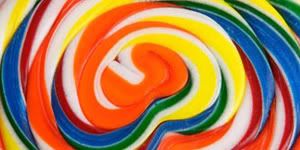Not Sir Phobos wrote:My favorite ending was from Giant Robo:
| He killed his sister to be able to destroy the world just to find out he was saving the world and his last request from his dad was to protect his sister. |
My friend and I jumped off the couch at the moment

Phobo-bobo, I agree that Giant Robo has the best conclusion of just about any anime I've ever seen. But you are slightly inaccurate in your understanding of the end. You are completely correct about the irony, the misunderstanding between father and son, there is no doubt about that. If you read the descriptions of my GR cels, you can piece together the plot as Imagawa Yasuhiro intended to disclose the events of Yokoyama Mitsuteru's manga series. My information is from countless viewings of GR, as well as research, reading interviews and a fairly exhaustive obsession ^_^
Here comes the world's most descriptive spoilers...
Imagawa Yasuhiro freely admits that some characters had to die while others he could never bring himself to kill off, among them included fan favorites like Tetsugyuu the Black Whirlwind (who was in fact killed but brought back later). For example, it is said (explicitly) that the use of Chief Chuujou Shizuo's "Human Bomb" technique will result in his immediate death. However, he performs (or prepares to perform) the attack three separate times during the course of the series. In one, he actually appears to have died. But Imagawa Yasuhiro brought him back. Another such instance involves a member of Big Fire, Juujoji the Bell of Life. He is actually killed (you see his mangled corpse and everything). But he is brought back in a later episode. A lot of this is by Imagawa Yasuhiro's own design, in order to mislead the audience. Imagawa Yasuhiro also contemplated bringing back other characters, one he mentions is Yoshi the Blue Skinned Beast. But he explains there was no real role necessary for her in the later episodes, so that idea was scrapped.
Also, there was such a large gap of time between each OAV episode (several years in fact) that some story elements were changed during the transition (notice each episode ends on a cliff hanger which afforded the creators some possible options). The Giant Robo series was a huge undertaking financially and was nearly cancelled several times due to budget issues. You can tell from the full animation that the frame rate is exceptionally high, involving complex scenes. Notice that there is never a lack of movement, not even for one second. Unlike TV series and most other anime (where the action might simply be the mouth flap of a character talking). Compare the quality of the first two episodes of the Gin Rei Special OAVs with the GR OAVs and the difference is like night and day.
Gin Rei does not remain dead at the end of the series. And the fate of Murasame is also in question. Here is the evidence to support these statements: As I mentioned before, Imagawa Yasuhiro admits he cannot and will not kill off certain characters (for whatever reasons) but does not reveal who and why (only through selective implication). Murasame and Gin Rei are perhaps the most popular characters from the series, among GR fans. Killing them off would, theoretically, be something he would not want to do.
Murasame and Gin Rei were lovers, as is revealed in the final episode. If you watch Gin Rei's teleportation into the Eye of Folger, there are pink sparkles which trail behind her. That would be Kenji Murasame. Their powers have mingled by this point. Affording Gin Rei the gift of immortality and Kenji the ability of teleportation. The dub and some subtitle tracks may be confusing, but during the final episode, Murasame says that he "cannot be killed" or he "will always come back." You can reference these lines from the script itself.
As for Gin Rei's appearance at the conclusion, there is a foreshadowing moment which alludes to the question, "Are Gin Rei and Kenji really dead?" That foreshadowing moment is found in the discourse between Kenji and Daisaku, where Kenji shoots himself in the head with a pistol in front of Daisaku. In that scene, Kenji does in fact die. The look on his face, his eyes wide open and blank, resemble that of Gin Rei at the end of the series. But Kenji, even in such a state, can return because he is "the Immortal." Therefore, when their (Gin Rei and Kenji) powers mingle, Gin Rei gains the ability to come back from the condition she was last seen in at the conclusion of the series.
Imagawa Yasuhiro, as he enjoys the art of "slight of hand" (something often referenced to in the dialogue of Komei the Master Tactician) does not show you a living Gin Rei in the concluding scenes of the series, you merely hear an innocent conversation between Genya and his sister, which is hopeful and sentimental. It's meant to comfort the audience and allow them to figure out what happened. It may be taking place in real time, or it is a flashback from happier times. The actual time frame is not as relevant as what the conversation symbolizes and what is said.
It is all very vague, but I'm fairly confident the evidence I've provided here argues the case for me. Imagawa Yasuhiro will not directly answer a lot of questions regarding the series, he hopes the audience can piece it together themselves. Thanks to Kenji, Gin Rei can come back to life. |


